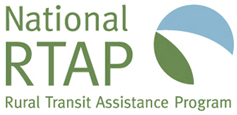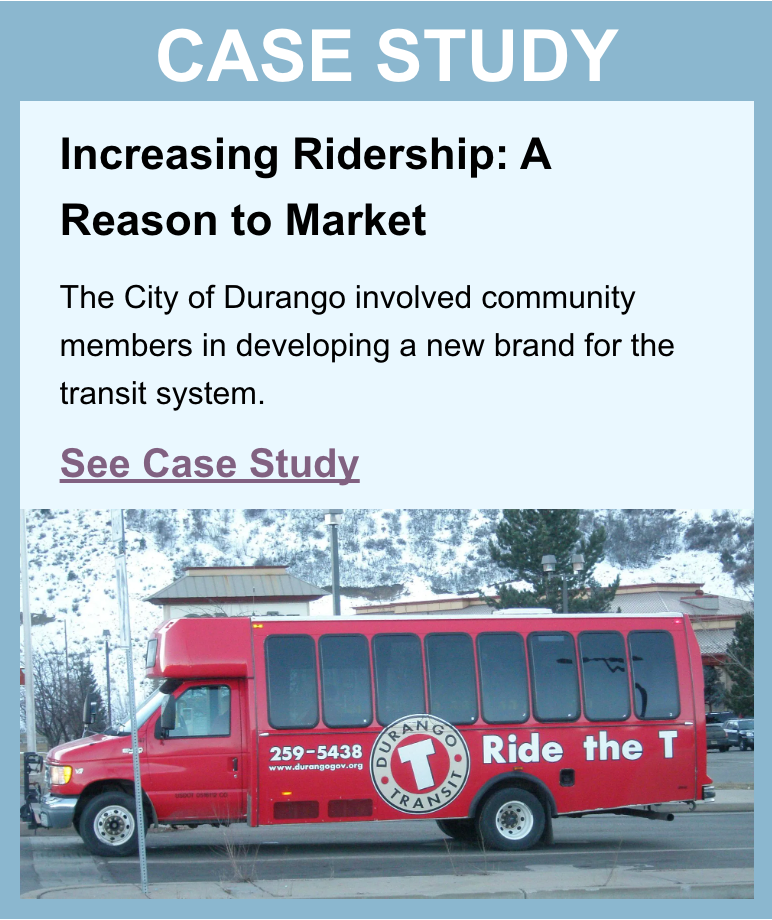How-To Guide for Marketing Transit
Welcome to the “How-To Guide for Marketing Transit,” a marketing “textbook” for transit agencies. This guide leads the reader through a process of understanding and implementing effective marketing for public transit, from broad marketing principles to detailed strategies for specific situations.
The “How-To-Guide” has five sections:
Marketing Basics
Marketing is the process of communicating about a product, whether a good or service, using a variety of tools that may include branding, advertising, events, public relations, posts on social media, and many other activities. Marketing provides a communications “big picture,” establishing a context to help people understand a product. One of marketing’s primary goals is to give a product a place in people’s minds.
Success in marketing begins with understanding the consumer, or audience, and their needs and wants. Through successfully implemented marketing strategies, the audience becomes aware of what a product is, how it works, and what it can do for them. Armed with this information, they can make informed decisions about purchasing or using that product.
What is Transit Marketing?
For a 60-minute overview of transit marketing,
click here to watch the Transit Marketing 101 webinar.
Unlike the marketing for consumer products, such as tissues or soft drinks, which is strictly focused on sales, transit marketing seeks to accomplish several objectives:
- Build visibility for transit and its role in a community
- Build support among decision-makers and community members
- Educate potential riders
- Generate ridership among those groups with transportation needs that the system can meet
Transit marketing is everything an agency does to communicate with riders, potential riders, and other important community stakeholders. A key principle of transit marketing is to understand the needs and concerns of each of these groups and how public transportation benefits them. That knowledge allows you to communicate with the most impact.
Because of public funding, transit has a special obligation to communicate effectively with those likely to be transportation-disadvantaged. Accessibility needs of persons with disabilities and accommodations for non-English-speaking populations are among the factors to consider in planning and implementing communications programs.
Click here for some tips about ADA and Title VI communications requirements. For more information about communications requirements, see the
ADA Toolkit and the
Transit Manager's
Toolkit Title VI section.
Another key principle of transit marketing is that, like operations and maintenance, it’s an ongoing effort. A single newspaper ad can be used to announce a service change. Free rides can increase ridership for a day. But only consistent, ongoing communication with riders, potential riders, and the community at large builds long-term awareness, support, and ridership.
Why Market Your System?
Ongoing marketing can bring positive attention to your system. A healthy, active marketing program can:
- Raise awareness
- Dispel misconceptions
- Provide transparency
- Increase ridership, including after a decline
- Develop relationships with community partners
- Satisfy funding requirements
These outcomes are related and build on one another, but they all start with raising awareness.
Raising Awareness
Instead of a “best-kept secret,” even the smallest transit system can become a familiar, useful, and popular part of its community with consistent marketing. Communicating with riders, potential riders, and your community establishes trust and builds and sustains visibility. Providing a true understanding of the system can increase ridership and community support.
Raising awareness begins with the fundamental communication strategies of branding and passenger information. These are essential marketing strategies that provide an identity and image for the system and directions for how to use it.
Marketing cannot fix poor or inadequate service
If service falls short — buses break down, schedules are unreliable — or it simply does not meet the needs of the target user, marketing will only make matters worse by offering a promise that the service cannot fulfill.
Dispelling Misconceptions
In many communities, transit is mistakenly thought of as a service only for older adults, persons with disabilities, or low-income riders. Would-be riders who don’t identify with those groups see no reason to try the service; they believe it’s restricted to certain kinds of riders and won’t meet their needs.
Another common misconception is that transit simply doesn’t exist in a community, a misconception that occurs in part because the service hasn’t been properly marketed. By raising awareness of what a system actually offers, marketing corrects misconceptions. Ongoing, thoughtful communications with messages and imagery that target audiences can relate to can clear up confusion and open the doors to new riders.
Increasing ridership is easier if the community supports your efforts and is willing to work with you. Marketing the system establishes it as an essential part of the community, an economic asset, and a point of pride. This marketing is even stronger when conducted in partnership with trusted groups in your community who serve your ridership base or can get your message out to their audiences.
Satisfying Funding Requirements
Many states tie their Section 5311 or other transit funding to ridership. Effective marketing generates the ridership that justifies grant expenditures and creates support for local match funding.
The costs of branding on vehicles and bus stop signs are capital expenses that can be paid with capital funding.
The FTA considers marketing expenses such as passenger guides, website development, and promotional activities as reimbursable under 5311 operations funding. It’s always a good idea to check with your state Department of Transportation to understand any state limitations.




